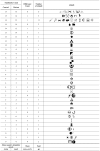Abnormal distracter processing in adults with attention-deficit-hyperactivity disorder
- PMID: 22457783
- PMCID: PMC3310872
- DOI: 10.1371/journal.pone.0033691
Abnormal distracter processing in adults with attention-deficit-hyperactivity disorder
Abstract
Background: Subjects with Attention-Deficit Hyperactivity Disorder (ADHD) are overdistractible by stimuli out of the intended focus of attention. This control deficit could be due to primarily reduced attentional capacities or, e. g., to overshooting orienting to unexpected events. Here, we aimed at identifying disease-related abnormalities of novelty processing and, therefore, studied event-related potentials (ERP) to respective stimuli in adult ADHD patients compared to healthy subjects.
Methods: Fifteen unmedicated subjects with ADHD and fifteen matched controls engaged in a visual oddball task (OT) under simultaneous EEG recordings. A target stimulus, upon which a motor response was required, and non-target stimuli, which did not demand a specific reaction, were presented in random order. Target and most non-target stimuli were presented repeatedly, but some non-target stimuli occurred only once ('novels'). These unique stimuli were either 'relative novels' with which a meaning could be associated, or 'complete novels', if no association was available.
Results: In frontal recordings, a positive component with a peak latency of some 400 ms became maximal after novels. In healthy subjects, this novelty-P3 (or 'orienting response') was of higher magnitude after complete than after relative novels, in contrast to the patients with an undifferentially high frontal responsivity. Instead, ADHD patients tended to smaller centro-parietal P3 responses after target signals and, on a behavioural level, responded slower than controls.
Conclusion: The results demonstrate abnormal novelty processing in adult subjects with ADHD. In controls, the ERP pattern indicates that allocation of meaning modulates the processing of new stimuli. However, in ADHD such a modulation was not prevalent. Instead, also familiar, only context-wise new stimuli were treated as complete novels. We propose that disturbed semantic processing of new stimuli resembles a mechanism for excessive orienting to commonly negligible stimuli in ADHD.
Conflict of interest statement
Figures






References
-
- Adams R, Finn P, Moes E, Flannery K, Rizzo AS. Distractibility in Attention/Deficit/Hyperactivity Disorder (ADHD): the virtual reality classroom. Child Neuropsychol. 2009;15:120–135. - PubMed
-
- Dopheide JA, Pliszka SR. Attention-deficit-hyperactivity disorder: an update. Pharmacotherapy. 2009;29:656–679. - PubMed
-
- Moss SB, Nair R, Vallarino A, Wang S. Attention deficit/hyperactivity disorder in adults. Prim Care. 2007;34:445–473. - PubMed
-
- Cycowicz YM, Friedman D. The old switcheroo: when target environmental sounds elicit a novelty P3. Clin Neurophysiol. 2004;115:1359–1367. - PubMed
-
- Debener S, Makeig S, Delorme A, Engel AK. What is novel in the novelty oddball paradigm? Functional significance of the novelty P3 event-related potential as revealed by independent component analysis. Brain Res. 2005;22:309–321. - PubMed
Publication types
MeSH terms
LinkOut - more resources
Full Text Sources
Medical

